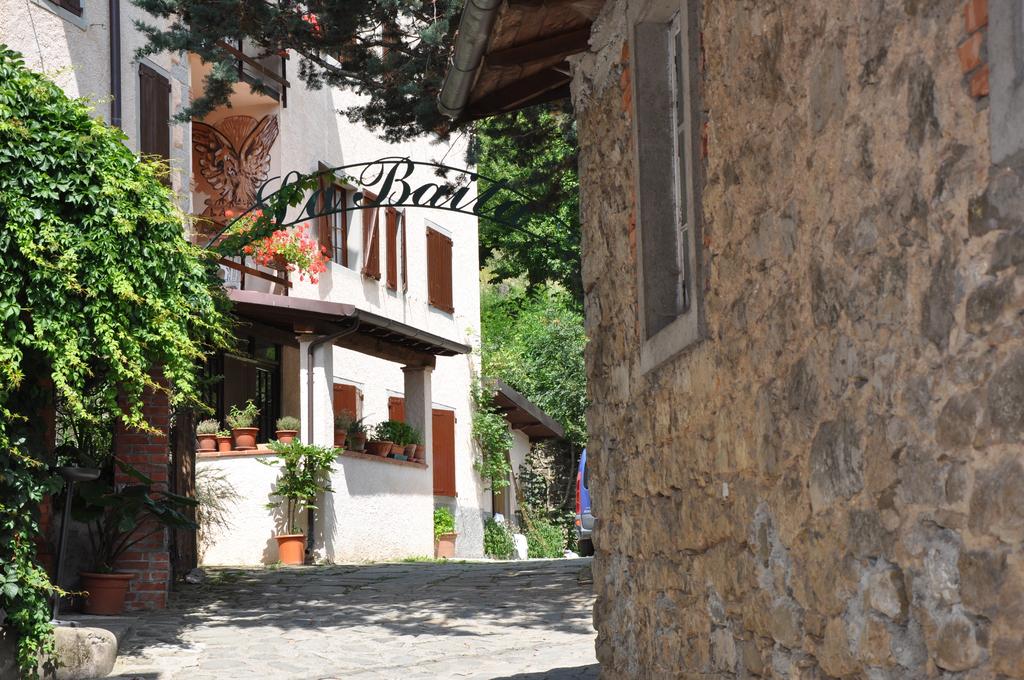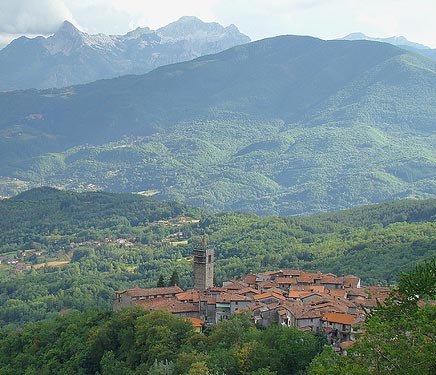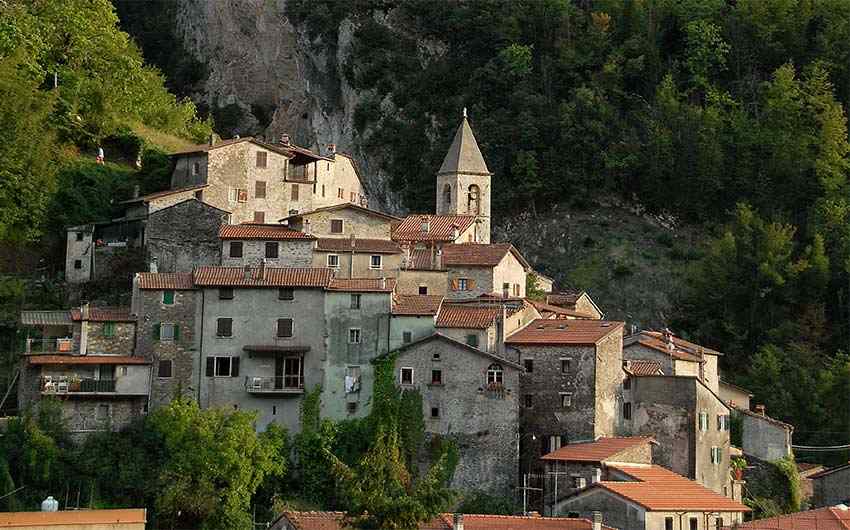
Track details
Distance
68.8km
Duration
22h 30min
Ascent
4313m
Descent
4018m
Starting altitude
490m
Arrival altitude
785m
Lowest point
216m
Highest point
1069m
Verrucole fortress
Deep in the Garfagnana, 3 kilometres from the municipality of San Romano, sits the imposing Verrucole Castle. The fortress is a very important medieval site, positioned on a hill 600 metres up, above the village of Verrucole.
Built by the Gherardinghi family, it was constructed around the 11th-12th century to dominate the area they ruled over and to oppose the Bacciano family in their claim over San Romano. The castle was made up of two distinct buildings, the Rocca Quadra and Rocca Tonda, located on each side of the hill and surrounded by a wall.
The Castrum Verrucolae Gherardinghi, as it was called on an imperial seal in 1376 by Charles IV, was later given to Spinetta Malaspina, a member of another one of the medieval power-holding families that dominated the border between Tuscany, Liguria and Emilia. Following the conflict between the Guelphs and the Ghibellines, the fortress was taken by the Florentines in 1430, by Lucca four years later, and finally by the Este family, who after 1446 subjected San Romano and its territory to their rule.
The castle can be reached on foot from the village of Verrucole, following the trail up the slopes of the hill. The fortress is open to visitors and you can enjoy a spectacular view of the Garfagnana valley and the Apuan Alps.
Verrucole fortress

Deep in the Garfagnana, 3 kilometres from the municipality of San Romano, sits the imposing Verrucole Castle. The fortress is a very important medieval site, positioned on a hill 600 metres up, above the village of Verrucole.
Built by the Gherardinghi family, it was constructed around the 11th-12th century to dominate the area they ruled over and to oppose the Bacciano family in their claim over San Romano. The castle was made up of two distinct buildings, the Rocca Quadra and Rocca Tonda, located on each side of the hill and surrounded by a wall.
The Castrum Verrucolae Gherardinghi, as it was called on an imperial seal in 1376 by Charles IV, was later given to Spinetta Malaspina, a member of another one of the medieval power-holding families that dominated the border between Tuscany, Liguria and Emilia. Following the conflict between the Guelphs and the Ghibellines, the fortress was taken by the Florentines in 1430, by Lucca four years later, and finally by the Este family, who after 1446 subjected San Romano and its territory to their rule.
The castle can be reached on foot from the village of Verrucole, following the trail up the slopes of the hill. The fortress is open to visitors and you can enjoy a spectacular view of the Garfagnana valley and the Apuan Alps.
Hotel LA BAITA
An excellent place to experience Garfagnan hospitality, while not giving up the comforts of a hotel. The family management of Roberto, Mara and Martina will make you a welcome guest for a day, and “family” already on the second evening ..
Hotel LA BAITA

An excellent place to experience Garfagnan hospitality, while not giving up the comforts of a hotel. The family management of Roberto, Mara and Martina will make you a welcome guest for a day, and “family” already on the second evening ..
+39 0583 660084
Corfino
Ancient village, whise settling dates back early middle age, when passages of animals, gods and pilgrims made happening a slow but steady settling, nested onto a perched plateau at the margins of a canyon and foothills of the mountain Pania di Corfino
It is believed that its toponimous is coming from “confinus” (border)
Corfino

Ancient village, whise settling dates back early middle age, when passages of animals, gods and pilgrims made happening a slow but steady settling, nested onto a perched plateau at the margins of a canyon and foothills of the mountain Pania di Corfino
It is believed that its toponimous is coming from “confinus” (border)
Equi caves
The Grotte di Equi karst complex is a registered geosite of the Apuan Alps Regional Park, which is a recognized Geopark in the European and Global Geoparks Networks (EGN-GGN) under the auspices of UNESCO.
The Equi cave complex developed over the course of hundreds of thousands of years thanks to the action of water, which over for millennia penetrated into fractures in the calcareous rock, eroding it and leaving behind features of great beauty and naturalistic interest: shafts, galleries, chambers, and underground lakes.
The Equi cave system extends for more than 1000 meters and may be subdivided into three parts.
- The “Buca” has been known since the early 1700s and was outfitted for excursions in the early 1960s. It is considered a fossil (“dead” or inactive) area, since water no longer flows in it.
- The “Grotte,” or caves as such, were discovered in the mid-1900s and fitted out for excursions in the mid-1980s. This area comprises the active portion of the complex and features a series of linked halls and chambers adorned with an infinite variety of natural mineral formations.
- The third and last part of the complex is not open to the general public and is accessible only to speleologists.
The cave tour itinerary passes through the Buca and the Grotte on a path about 500 meters in length.
An underground river runs through the Equi caves and surfaces near the entrance. In case of heavy rains, the cavity is liable to flood and spectacular and violent water outflows into the Fagli stream may occur.
Equi caves

The Grotte di Equi karst complex is a registered geosite of the Apuan Alps Regional Park, which is a recognized Geopark in the European and Global Geoparks Networks (EGN-GGN) under the auspices of UNESCO.
The Equi cave complex developed over the course of hundreds of thousands of years thanks to the action of water, which over for millennia penetrated into fractures in the calcareous rock, eroding it and leaving behind features of great beauty and naturalistic interest: shafts, galleries, chambers, and underground lakes.
The Equi cave system extends for more than 1000 meters and may be subdivided into three parts.
- The “Buca” has been known since the early 1700s and was outfitted for excursions in the early 1960s. It is considered a fossil (“dead” or inactive) area, since water no longer flows in it.
- The “Grotte,” or caves as such, were discovered in the mid-1900s and fitted out for excursions in the mid-1980s. This area comprises the active portion of the complex and features a series of linked halls and chambers adorned with an infinite variety of natural mineral formations.
- The third and last part of the complex is not open to the general public and is accessible only to speleologists.
The cave tour itinerary passes through the Buca and the Grotte on a path about 500 meters in length.
An underground river runs through the Equi caves and surfaces near the entrance. In case of heavy rains, the cavity is liable to flood and spectacular and violent water outflows into the Fagli stream may occur.
Equi Terme
For centuries rainwater has been collected by the majesty of the mountains here, filtered into the subsoil, enriched with mineral salts that are beneficial to our health and then put back on the surface where they are collected and used not far a short distance from the medieval village. The marble core of the Apuan Alps is the origin of the healing waters that fuel the Terme di Equi baths.
The chloride-sulphate-sodium waters are classed as mineral springs. Ranging between 17 and 27°C, with an average of 24°C, these waters are regarded as hypothermal.
The waters are used to heal health problems affecting the respiratory and otolaryngology systems (pharyngitis, sinusitis, rhinitis, laryngitis, tracheitis, bronchitis, rhinogenic deafness), skin complaints (eczema, acne, itchy skin, psoriasis), bone and joint problems (arthrosis, chronic primary polyarthritis, rheumatism in the joints, fibrositis, joint distractions, post-fractures, sciatic and lumber pain) and angiology (vasculopathy, chronic phlebopathy) through bathing from 36° to 39°C and in thermal pools at 27°C, as well as the general and localized hydromassage with thermal water, inhalations, aerosols, vaporizers, nasal irrigation, and general and partial massages.
Equi caves in Lunigiana
Equi caves in Lunigiana – Credit: GAL Lunigiana
For those seeking relaxation and wellness at Terme di Equi, try the steam room, solar shower, massages that tone and soothe, algae, mud and cold-compress treatments, beauty services and even a range of cosmetic products for the face and body.
Close to the bath, the Grotte di Equi are worth a visit, a karst complex of caves in the Apuan Alps Regional Park and acknowledged by UNESCO as a Geopark, formed over thousands of years by water erosion, carving underground tunnels, lakes and wells that are fascinating to see.
Info: termediequi.it
Equi Terme

For centuries rainwater has been collected by the majesty of the mountains here, filtered into the subsoil, enriched with mineral salts that are beneficial to our health and then put back on the surface where they are collected and used not far a short distance from the medieval village. The marble core of the Apuan Alps is the origin of the healing waters that fuel the Terme di Equi baths.
The chloride-sulphate-sodium waters are classed as mineral springs. Ranging between 17 and 27°C, with an average of 24°C, these waters are regarded as hypothermal.
The waters are used to heal health problems affecting the respiratory and otolaryngology systems (pharyngitis, sinusitis, rhinitis, laryngitis, tracheitis, bronchitis, rhinogenic deafness), skin complaints (eczema, acne, itchy skin, psoriasis), bone and joint problems (arthrosis, chronic primary polyarthritis, rheumatism in the joints, fibrositis, joint distractions, post-fractures, sciatic and lumber pain) and angiology (vasculopathy, chronic phlebopathy) through bathing from 36° to 39°C and in thermal pools at 27°C, as well as the general and localized hydromassage with thermal water, inhalations, aerosols, vaporizers, nasal irrigation, and general and partial massages.
Equi caves in Lunigiana
Equi caves in Lunigiana – Credit: GAL Lunigiana
For those seeking relaxation and wellness at Terme di Equi, try the steam room, solar shower, massages that tone and soothe, algae, mud and cold-compress treatments, beauty services and even a range of cosmetic products for the face and body.
Close to the bath, the Grotte di Equi are worth a visit, a karst complex of caves in the Apuan Alps Regional Park and acknowledged by UNESCO as a Geopark, formed over thousands of years by water erosion, carving underground tunnels, lakes and wells that are fascinating to see.
Info: termediequi.it